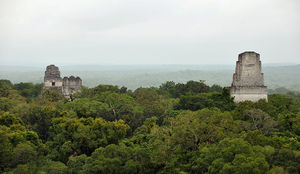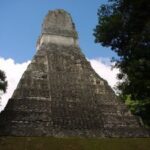There has been much excitement regarding the Mayan calendar, especially noting that it “ends” on Dec 21, 2012 – according to the calendar. On a recent trip to Belize in central America, my wife and I visited several of the Mayan sites. We visited Tikal to the west. She and I actually sat on Temple IV, looking out at the scene in the accompanying picture. Yes, you may climb Temple IV, and look out at Temples III, II and I; it is the same scene from Return of the Jedi.
Understand the Mayan Calendar
Many of the temples were erected in accordance with astronomical observations. Those observations gave us the Mayan calendar. Some of the temple sites where elements of the calendar can be seen are at Tikal, massive Caracol, romantic Xunantunich, and the archaeological wonder of Luubantun. There are a number of other sites that have elements of the calendar: Altun Ha and Lamanai in the north of Belize, Nim Li Punit and Uxbenka in the south, the Toledo district.
In addition to the fascinating archaeology of the Mayan area in Belize, we had the chance to understand the Mayan calendar. The public image of elaborately carved hieroglyphs on stone monuments, and stone temples rising above the jungle canopy on tall pyramidal bases give a popular impression of mystery surrounding the Maya. Photographs of ruined temple sites engulfed by tropical vegetation seem out of an Indiana Jones epic.
Modern scholarship has clarified the understanding of the classic Mayan culture. The classic period (AD 250-AD 1100) distinguishes the peak of Maya achievement from development to decline. Recent scholarship and work in deciphering Maya hieroglyphic writing has given us a new understanding of Maya history and the calendar.
Archaeology
Archaeological study includes objective and refined methods describing changes related to architecture, engineering, settlement and burial practices, and other cultural features. This includes the measurement of time, and use of the Maya calendar. The Maya calendar is different from our Gregorian calendar.
The Maya calendar was in use for over 850 years. Our current Gregorian calendar has only been in use for 600 years. The Maya calendar has been studied and published thoroughly. Time was a sacred and magical concept. Maya time was based on a vigesimal system, based on units of 20, unlike our decimal system of 10.
Recording an accurate passage of time arises from agriculture. Food supply is essential for population development and growth. A well-educated Mayan would understand the seasons’ cycle of dry and wet periods to properly time planting, growth and harvest.
Units of Time
Like us, the basic unit of time – the day – is based on the sun’s movement, perceived by the Maya as a male deity named Kinich Ahau. Indviduals who mastered the movements of the sun, moon and stars were honored, even revered. Kings and priests kept the knowledge for giving a bountiful harvest. Mayan deity was associated with different days, with good or bad natures. Mayan deity were, after all, modeled on human nature.
Good or bad days were beneficial (or not) for planting and harvesting, in addition to giving childbirth, going to war with neighbors, etc. Timing the sun and seasons was originally necessary for survival; it was later elevated to an instrument of mystic astrology. Keeping a written record of time required literacy and mastery of writing. This skill was restricted to the Maya elite.
Three Mayan Calendars
There is no way to simplify the Maya calendar system. There were at least three different calendars. The “Sacred calendar” had 13 numbers and 20 names, which cycled together back to the beginning combination. Each day had an associated deity. A sample notation would be 6 Ahau 13 Muan.
The second calendar is the “Vague Year.” This Mayan calendar contained 365 days, based on solar movement. Fractions of a day were not expressed in the Mayan calendar, so no leap year existed. Instead, a calendar of 18 months had 20 days each. An added 5 days brought them to a true solar year.
This counting cycle could not recur for 52 years. Because it would recycle, the Maya calendar needed another count to distinguish dates more than 52 years apart. This Maya calendar is the Long Count, the calendar that ends on our Dec 21, 2012.
Long count days do not recur. They needed a fixed starting date, similar to our 1 BC. The Maya calendar began on the mythical date corresponding to our 11 August 3114 BC. It needed to accommodate long time periods. It uses escalating positions, just like we use large numbers going from 100 to 1,000 to 100,000.
Learn the Mayan Calendar
For example, our year 1492 indicates 2 units of 1, 9 units of 10, 4 units of 100, and 1 unit of 1,000. The Maya long Count calendar used five positions for each day. A day was called a kin, the same 24 hour period we recognize. The kin was the first position, corresponding to our units. The second position used 20 kins to make a month, a uinal.
The third notation deviated from the base 20 system. 18 uinals made a 360 day tun (18 X 20). Add the five day adjustment, you have a solar year; it is the same year for the Maya calendar as for our calendar. The next digit reverts to a vigesimal (base 20) 20 tuns, or 20 years, called a katun.
The katun was very important. Dated monuments were erected celebrating its end. The last position was a baktun, a 400 year cycle. This digit could count from the beginning of the Maya calendar (3112 BC) to the Maya present (say, around AD 711), and even look as far forward as 1100 years, leading us to 21 Dec. 2012. A day in the Long Count would look like this:
9.14.0.0.0 6 Ahau 13 Muan
Five digits, plus the number and deity name, another number and deity name complete the date. This reads 9 baktuns, 14 ketuns, no tuns, no uinals, no kins; the 6th day named Ahau, and the 13th day in the month of Muan. This is the end day of the 14th katun, which is why there are no new tuns, uinals or kins. This date correlates with Dec 1, 711 AD, a date found on an actual stele at Tikal. The Maya system is complex, yet similar to ours as it records time passed from a fixed date.
It’s Not the End of the World
On our date of Dec. 20, 2012, the Maya calendar records 12 baktuns, 19 ketuns, 19 tuns, 17 uinals, and 19 kins. Think of your car odometer. The next rotation of the odometer after 99,999 is 100,000. But if your odometer only reads five places, it would next read: “00,000.” This is similar to the reading of the Maya calendar for December 21, 2012: 0.0.0.0.0. (This is a simplified explanation, intended for a lay reader. An accomplished Mayanist would write the next katun as 13.0.0.0.0).
But there is good news. It may not be the end of the world, just the end of the baktun. On Dec. 31, 2011, you simply threw away your 2011 calendar, and got a new calendar. Back in AD 711, perhaps they saw no need to construct a new calendar going past 2012. After all, they had 1300 years to propose a new calendar. We use the Gregorian calendar, and we have only been using it for 600 years, since AD 1582. Who knows? 600 years from now, we may not be using the same calendar. Perhaps we will be using Star Trek’s “star dates!”
There is still good news, even if the world faces a catastrophe. You will survive better if you read Seven priorities for disaster survival.




